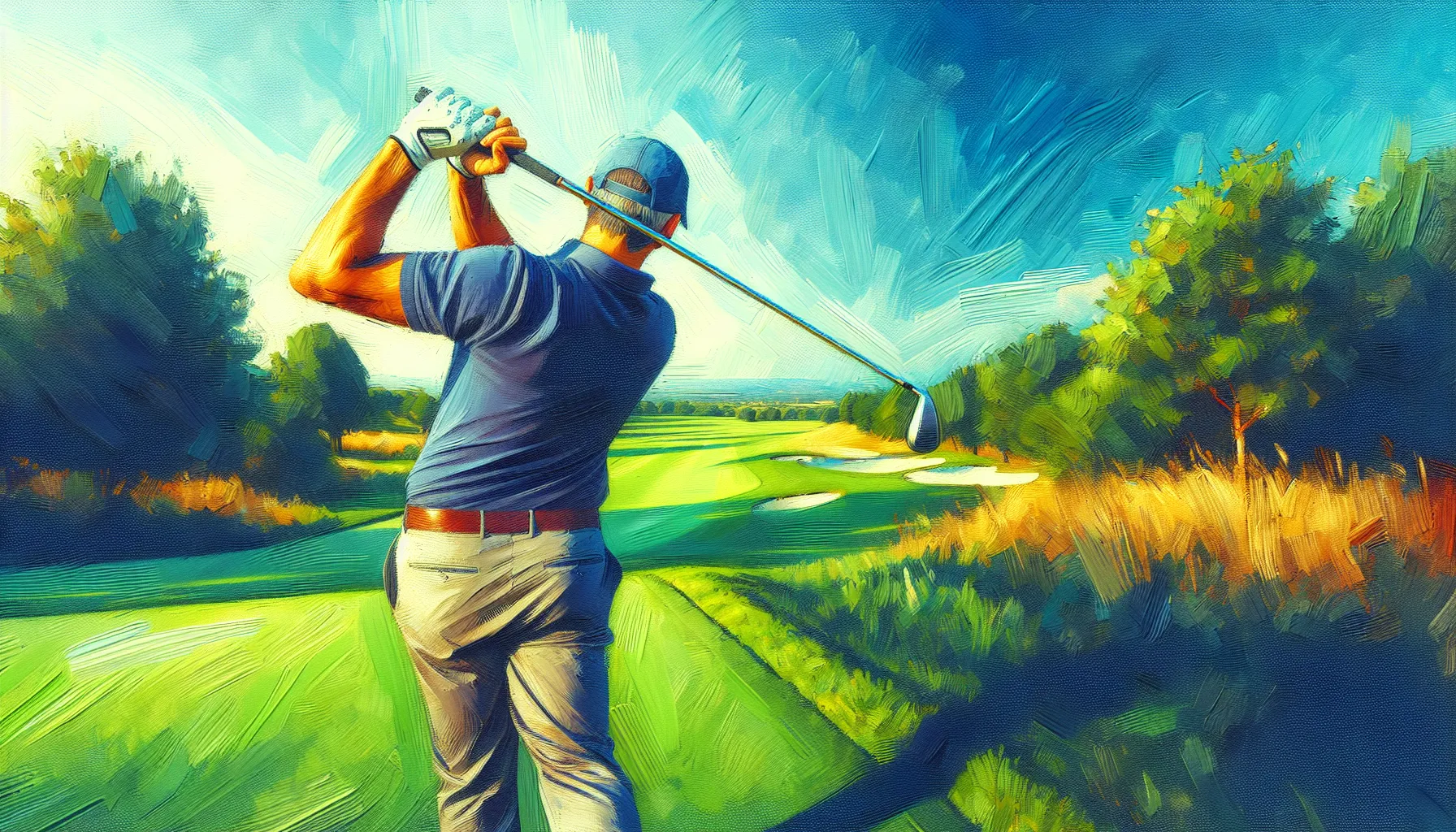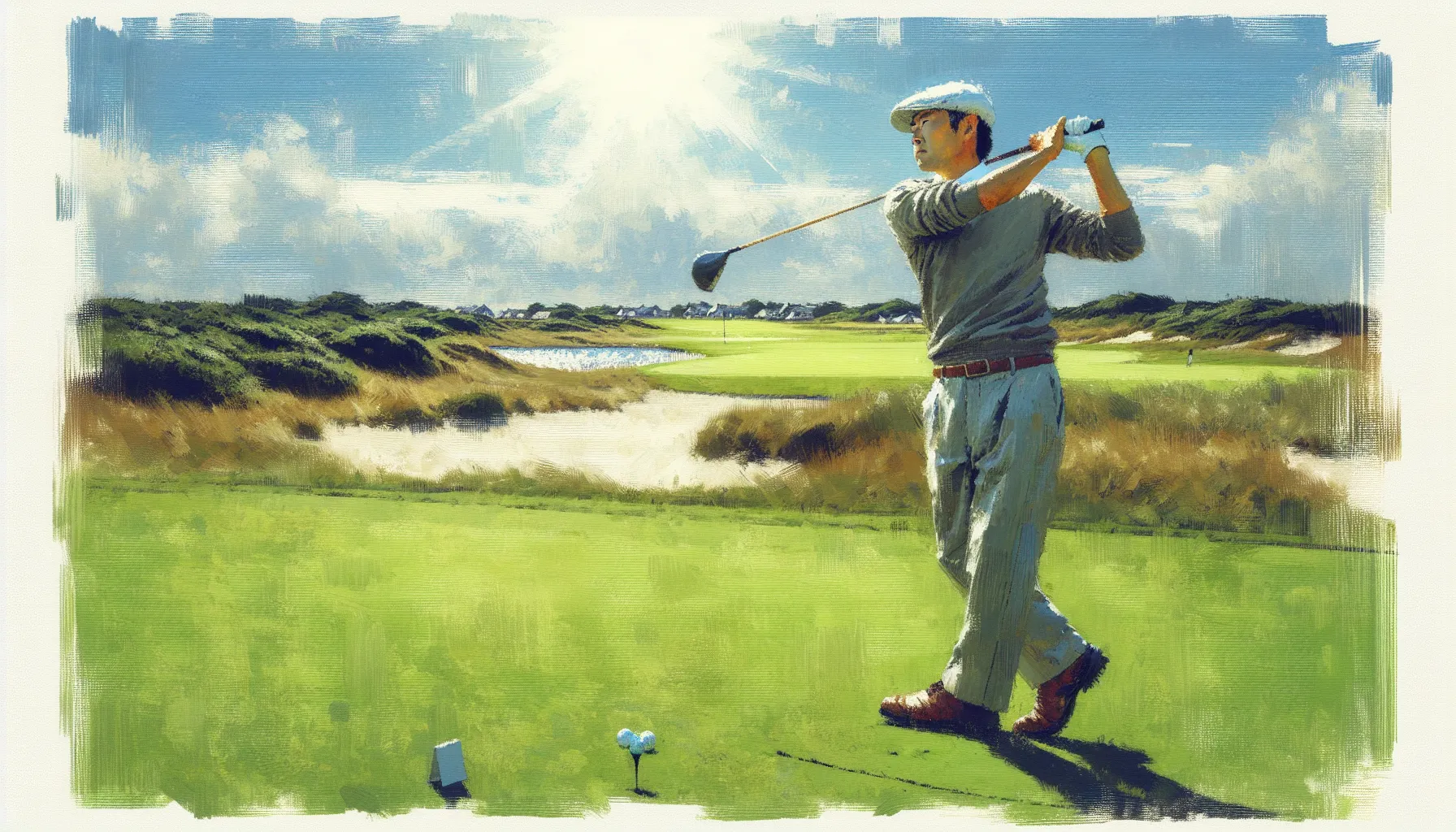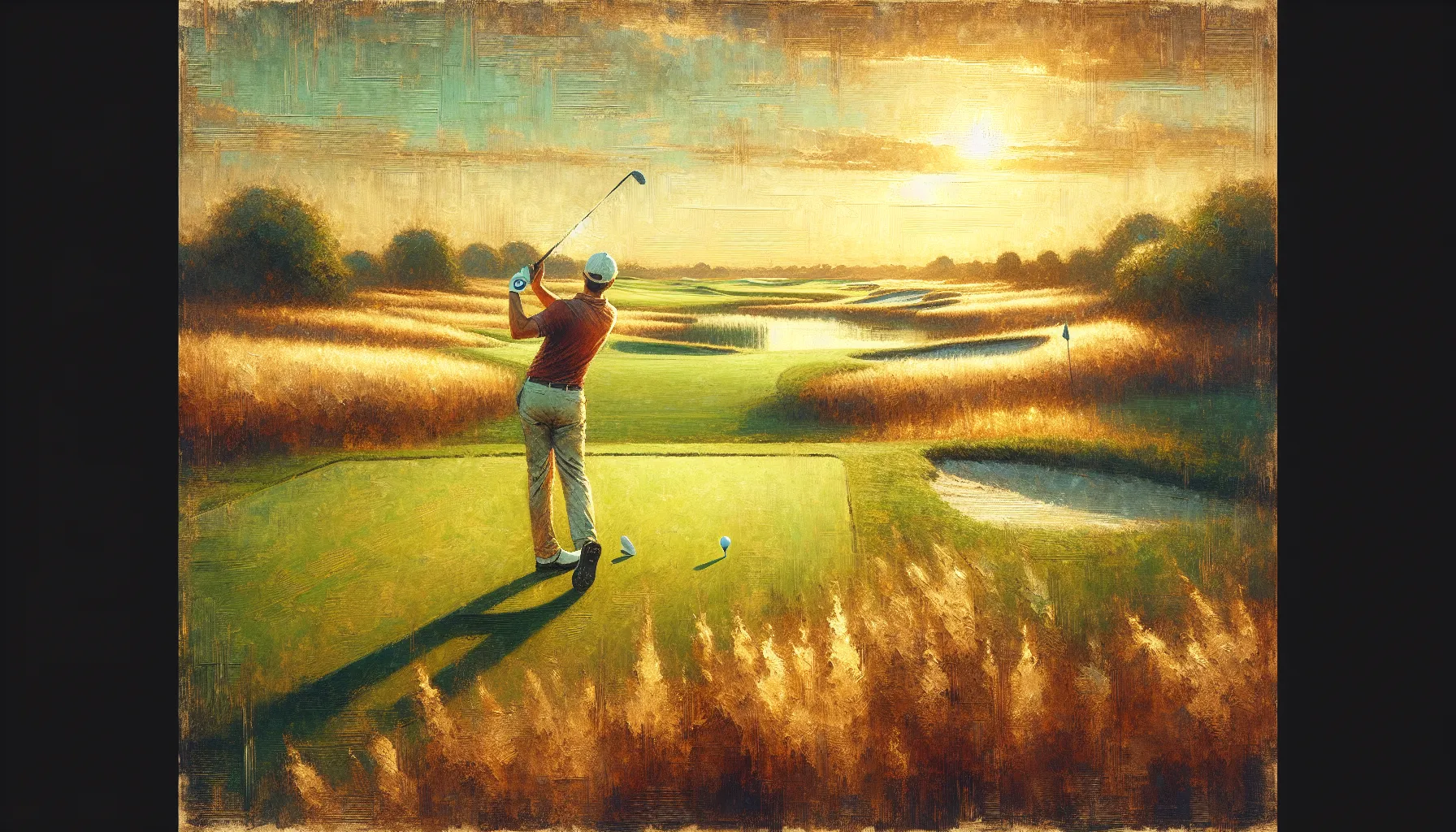Master Your Short Game: A Weekend Golfer's Guide to Lower Scores
Tired of watching those precious strokes slip away around the green? I've been there, and I'm here to help. In this guide, we'll dive into the secrets of improving your short game, from chipping and pitching to bunker play and putting. By the end, you'll have the tools to shave strokes off your score and finally beat your buddies. Plus, don't miss our interactive quiz, key takeaways, and personalized improvement planner at the bottom. Let's get ready to dominate the scoring zone!
Picture this:
You've just crushed a drive down the fairway, feeling like a golf god. But as you approach the green, that familiar knot forms in your stomach. You know what's coming – the dreaded chip shot that'll either soar over the green or barely make it halfway. Sound familiar? I've been there, my friend. For years, my short game was the Achilles' heel of my golf performance, costing me strokes and leaving me frustrated after every round.
Let's face it – a weak short game is more than just a minor inconvenience. It's the difference between breaking 90 and settling for triple digits. It's the reason your buddies are sinking those up-and-downs while you're three-putting. Worst of all, it's robbing you of the joy and satisfaction that comes with playing your best golf. You've invested in lessons, bought the latest wedges, and spent countless hours on the practice green.
So why aren't you seeing results?
But here's the good news – it doesn't have to be this way. I've discovered that improving your short game isn't about natural talent or expensive equipment. It's about understanding the right techniques, practicing smart, and developing the mental game to match. In this guide, I'm going to share the exact strategies that helped me transform my short game from a liability into a secret weapon.
We'll cover everything from chipping and pitching basics to advanced green-reading techniques and pressure-proof putting drills. By the time we're done, you'll have a complete toolkit to start shaving strokes off your score and finally achieve the consistency you've been chasing.
So grab your wedge, and let's dive in – it's time to master your short game and take your golf to the next level!
The Day I Discovered the Secret to Short Game Mastery
Picture this: It's a crisp Saturday morning, and I'm standing over a delicate chip shot on the 18th hole. My buddies are watching, and I'm one up in our weekly match. All I need is to get this ball close and secure the victory.
I take a deep breath, remembering all the YouTube tutorials I've watched. I set up, take my swing, and... chunk it. The ball barely makes it halfway to the green. My opponents can hardly contain their glee as I scramble to make bogey and lose the match.
Frustrated and deflated, I head to the practice area, determined to figure out what I'm doing wrong. That's when I notice an older gentleman effortlessly chipping balls to within a foot of the pin, time after time. Intrigued, I strike up a conversation.
"Son," he says with a knowing smile, "the secret to a great short game isn't in your hands – it's in your feet."
He spends the next hour showing me how a stable lower body and proper weight distribution can transform your chipping and pitching. It was like a lightbulb went off in my head. Suddenly, those tricky shots around the green started to make sense.
The wisdom from that chance encounter completely transformed my short game. I went from dreading those delicate shots to actively seeking them out, knowing I had the skills to pull them off.
And here's what that means for YOU:
You don't need to spend hours watching instructional videos or buying the latest wedges to improve your short game. Sometimes, the simplest adjustments can make the biggest difference. By focusing on your lower body stability and weight distribution, you can start seeing immediate improvements in your chipping and pitching. Not only will this help you save strokes, but it'll also give you the confidence to take on those tricky shots around the green.
So the next time you're out on the course, remember – the secret to a killer short game might just be right under your feet!
 Master the art of the short game with these expert tips and techniques.
Master the art of the short game with these expert tips and techniques.1. The Importance of Short Game in Golf
Let's face it, fellow weekend warriors – we all dream of crushing 300-yard drives down the middle of the fairway. But here's a little secret I've learned over years of battling my buddies on the links: it's the short game that separates the winners from the also-rans.
I remember the day this truth really hit home. I'd just outdriven my playing partners by a good 30 yards on a par 4, feeling like the next Bryson DeChambeau. But three clumsy chips and two nerve-wracking putts later, I'd turned a potential birdie into a momentum-killing double bogey. Meanwhile, one of my playing partners, who'd barely reached the fairway off the tee, got up and down with a silky chip and a single putt. That, my friends, is the power of a solid short game.
So, if you're tired of watching those precious strokes slip away around the green, stick with me. We're about to dive into the secrets that'll transform your short game from a liability into your secret weapon.
2. Understanding the Components of Short Game
Before we start dropping shots off your handicap, let's break down what we mean by "short game." It's not just one skill, but a combination of several crucial techniques:
- Chipping: Those low, running shots from just off the green.
- Pitching: Higher, softer shots that fly more and roll less.
- Bunker Shots: The art of escaping those dreaded sand traps.
- Putting: The final act, where matches are won and lost.
Each of these skills requires its own technique and strategy, but they all share one common goal: getting the ball in the hole in as few strokes as possible. Master these, and you'll be well on your way to golf greatness (or at least to finally beating your smug golf buddy).
 Learn to finesse your short shots and watch your golf scores plummet.
Learn to finesse your short shots and watch your golf scores plummet.3. Key Techniques to Improve Your Short Game
Alright, let's get into the nitty-gritty of how to actually improve your short game. Here are some key techniques that'll have you chipping and putting like a pro (or at least a very skilled amateur):
Proper Grip and Stance:
For chipping and pitching, I like to use a slightly narrower stance with the ball positioned back in my stance. This promotes a downward strike and better contact. As for grip, I've found that choking down on the club a bit gives me more control.
Reading Greens:
This is where the real magic happens in putting. I always take a walk around the green before putting, looking for slopes and grain direction. A little tip I picked up: the grass is usually darker when you're putting into the grain.
Distance Control:
This is crucial for all short game shots. For chips and pitches, I practice by trying to land the ball on specific targets. For putting, I use the "ladder drill" – putting to different distances to dial in my feel.
Shot Selection:
Knowing when to chip, pitch, or putt is half the battle. I always ask myself: "What's the safest way to get this ball close to the hole?" Sometimes, pulling out the putter from off the green is the smartest play.
4. Practice Drills for Short Game Improvement
Now, I know what you're thinking – "Johnny, this all sounds great, but how do I actually practice this stuff?" Well, I've got you covered with some of my favorite drills:
Chipping Drill: The Clock Drill
Set up 12 balls in a circle around a hole, like the numbers on a clock face. Try to chip each ball into the hole, working your way around the clock. This helps you practice different angles and distances.
Pitching Drill: Landing Zone Practice
Place a towel or alignment stick on the green as a target. Practice pitching balls to land just on the near edge of the target. This helps you dial in your distance control.
Bunker Drill: Dollar Bill Drill
Place a dollar bill in the sand and try to hit it out of the bunker without touching the bill. This promotes hitting the sand first, not the ball.
Putting Drill: Gate Drill
Set up two tees just wider than your putter head about 3 feet from the hole. Practice putting through this "gate" to improve your accuracy on short putts.
5. Mental Strategies for Short Game Success
Here's something they don't tell you in those golf magazines – the short game is as much mental as it is physical. Here are some mind tricks I use to stay cool under pressure:
Visualization Techniques:
Before every shot, I take a moment to visualize the ball's path to the hole. I see it landing, rolling, and dropping in. It's like giving my brain a roadmap to success.
Managing Pressure:
When the heat is on, I focus on my breathing. A few deep breaths can do wonders for steadying those shaky hands. Remember, it's just a game (even when your buddy is trash-talking about the $5 Nassau).
Building Confidence:
Confidence is key in the short game. I keep a "success journal" where I write down my best short game shots after each round. When I'm feeling doubtful, a quick read helps me remember that I've pulled off great shots before.
 Transform your short game from a weakness into your golfing superpower.
Transform your short game from a weakness into your golfing superpower.6. Equipment Considerations for Short Game
Now, I'm not saying you need to go out and buy a whole new set of wedges (though if you do, can I come with?). But having the right tools for the job can make a big difference in your short game.
Wedge Selection:
I carry three wedges – a pitching wedge, sand wedge, and lob wedge. This gives me options for different shots around the green. The key is to have a good gap between lofts so you're covered for any situation.
Putter Fitting:
Getting fitted for a putter was a game-changer for me. The right length, lie angle, and head style can make a huge difference in your putting consistency.
7. Common Short Game Mistakes and How to Avoid Them
Let's talk about some of the blunders I see (and have made myself) in the short game:
Deceleration Nation:
The Problem: You get nervous about hitting the ball too far, so you slow down your swing at impact. The result? A chunked chip or a putt that dies before reaching the hole.
The Fix: Focus on accelerating through the ball. I like to think of my swing as a pendulum - smooth back, smooth through, with the fastest point being just after impact.
The Wristy Wonder:
The Problem: You try to help the ball into the air by flicking your wrists. Hello, skulled chips and inconsistent contact!
The Fix: Keep those wrists firm, my friends. Let the loft of the club do the work. I practice chipping with a tee tucked under my leading arm to prevent those pesky wrist breaks.
Green Misread Madness:
The Problem: You're convinced that 3-foot putt breaks 6 inches left to right. Spoiler alert: it doesn't.
The Fix: Trust your eyes, but verify with your feet. I always walk around my putts to feel any slope with my feet. And remember, most amateur golfers overread break. When in doubt, trust a straighter line.
Bunker Burial Services:
The Problem: You try to lift the ball out of the sand, resulting in either a skull across the green or a sad little plop as your ball buries deeper.
The Fix: Hit the sand, not the ball. I imagine trying to slide a dollar bill under the ball and out the other side. This promotes the right angle of attack and prevents those embarrassing bunker blunders.
The "I Got This" Syndrome:
The Problem: You've got a tricky pitch over a bunker to a tight pin. Instead of playing it safe, you go for glory... and end up in the sand.
The Fix: Always ask yourself, "What's the safest way to get this ball close?" Sometimes, that means aiming away from the pin to give yourself an easier next shot. Golf is about playing the percentages, not being a hero (unless you're Phil Mickelson, then by all means, go for it).
8. Integrating Short Game Practice into Your Routine
Well, my fellow golf nuts, we've covered a lot of ground here. From chipping techniques to mental game strategies, you've now got a full arsenal of short game weapons. But here's the kicker - all this knowledge won't mean squat if you don't put it into practice.
I get it, we're weekend golfers. Between work, family, and trying to maintain some semblance of a social life, finding time to practice can be tougher than a $2 steak. But here's how I manage to keep my short game sharp without letting my wife think I've abandoned her for my wedges:
1. The Living Room TV Challenge:
I keep a putter at home and practice my stroke while watching TV.
2. The Backyard Chipping Arena:
I've set up a small chipping area in my backyard. Nothing fancy, just a patch of grass and an old flagstick. Even 10 minutes of practice while the grill is heating up can make a big difference.
3. The Pre-Round Ritual:
I always arrive at the course 30 minutes early to warm up. But instead of pounding drivers, I spend most of that time on the practice green. It sets the tone for the round and gets my touch dialed in.
4. The Mental Game Commute:
Stuck in traffic? Perfect time for some visualization practice. I mentally play my home course, focusing on the short game shots. It's like a golf meditation, minus the incense.
Remember, improving your short game is a journey, not a destination. There will be ups and downs, miraculous up-and-downs, and the occasional chunked chip that makes you question why you ever picked up this maddening sport. But stick with it, and I promise you'll start seeing results.
So, next time you're out on the course and you're faced with a tricky chip or a nerve-wracking 5-footer, take a deep breath, remember what we've discussed here, and trust your skills. You've got this!
Now, if you'll excuse me, I've got a date with my practice green. Those putts aren't going to sink themselves!
Mastering Your Short Game: Key Takeaways for Instant Improvement
Alright, weekend warriors, let's recap the game-changing insights we've covered. These nuggets of wisdom are your fast-track ticket to dominating the short game and leaving your buddies in awe. Here are the core actionable takeaways you can start using immediately:
• It promotes a downward strike on chips and pitches so you can make cleaner contact, which means more consistent shots around the green.
• It allows you to read greens more accurately so you can predict ball roll better, which means fewer three-putts and more clutch par saves.
• It improves your distance control so you can leave yourself shorter second putts, which means lower scores and more confidence on the greens.
• It helps you select the right shot for each situation so you can play percentage golf, which means smarter decision-making and fewer short game disasters.
• It enhances your bunker play technique so you can escape sand traps more efficiently, which means turning bogeys into pars and saving crucial strokes.
Remember, improving your short game is about consistent practice and smart strategies, not expensive equipment or natural talent. Focus on these key areas, and you'll be well on your way to lower scores and bragging rights at the 19th hole.
So, are you ready to transform your short game and start shocking your golfing buddies with your newfound skills?
The practice green is calling your name, and those crisp chips and clutch putts are just waiting to be unleashed. Don't wait for the "perfect" moment to start improving - that moment is now. Head to the course this weekend, apply these tips, and watch your scores drop faster than a well-executed flop shot. Remember, every stroke you save around the green is another step closer to winning those weekend matches.
So, what are you waiting for?
Grab your wedges, hit the practice area, and let's turn that short game from a weakness into your secret weapon!
How to Improve Short Game in Golf: Your Questions Answered
How can I improve my short game fast?
How can I improve my short game fast?
To improve your short game quickly, focus on these key areas: practice your chipping and putting daily, even if just for 15 minutes. Work on distance control by using the ladder drill. Improve your feel by practicing with your eyes closed. And don't forget to work on your mental game – visualization and pre-shot routines can make a big difference. Remember, consistent practice is more effective than sporadic long sessions.
What percentage of golf is short game?
What percentage of golf is short game?
The short game typically accounts for about 60-65% of your total shots in a round of golf. This includes all shots within 100 yards of the green, as well as putting. That's why improving your short game can have such a dramatic effect on your scores – you're working on the majority of your shots!
How do you practice short game at home?
How do you practice short game at home?
You don't need a full golf course to practice your short game. Set up a putting mat in your living room for daily practice. Use plastic practice balls to chip in your backyard or even indoors. Work on your wedge play by chipping to targets like buckets or hula hoops. You can even practice your bunker technique by drawing a line in a sandbox or on a beach!
How often should I practice my short game?
How often should I practice my short game?
You're probably thinking you need to spend hours every day on your short game, right? Well, actually, consistency is more important than duration. Aim to practice your short game at least 3-4 times a week, even if it's just for 20-30 minutes. Regular, focused practice sessions will yield better results than sporadic marathon sessions.
What are the best drills for improving chipping?
What are the best drills for improving chipping?
Some effective chipping drills include the clock drill (placing balls in a circle around the hole), the up-and-down challenge (trying to get up and down from various lies), and the landing zone drill (focusing on landing the ball in a specific area). Remember to practice from different lies and distances to improve your versatility.
How can I improve my putting accuracy?
How can I improve my putting accuracy?
To improve putting accuracy, start with the gate drill: set up two tees just wider than your putter head and practice putting through them. Work on your alignment by using a line on your ball. Practice lag putting to improve distance control. And don't forget to spend time reading greens – the best line doesn't matter if you don't know where to aim!
What's the secret to good bunker play?
What's the secret to good bunker play?
The key to good bunker play is hitting the sand first, not the ball. Practice the dollar bill drill: place a dollar bill in the sand and try to hit it out without touching the bill. Open your clubface for more loft, dig your feet in for stability, and focus on hitting about an inch behind the ball. And remember, follow through! Many bunker struggles come from deceleration.
How do I know which wedge to use for different shots?
How do I know which wedge to use for different shots?
You're probably thinking you need a different wedge for every situation, right? Well, actually, it's more about knowing your distances and ball flights with each wedge. Practice with each of your wedges from various distances and lies. Learn how to control trajectory by adjusting ball position and swing length. With practice, you'll develop a feel for which club to use in different situations.
What's the best way to improve my pitch shots?
What's the best way to improve my pitch shots?
For pitch shots, focus on maintaining a consistent tempo and using your body rotation, not just your arms. Practice the 9-3 drill: swing the club back to 9 o'clock and through to 3 o'clock for consistent contact. Work on controlling distance by varying the length of your backswing while keeping the same tempo.
How can I stop chunking my chip shots?
How can I stop chunking my chip shots?
Chunking often comes from trying to lift the ball instead of letting the club do the work. Focus on keeping your weight forward, hands ahead of the ball at impact, and hitting down and through. Practice the coin drill: place a coin just in front of your ball and try to hit the coin after striking the ball.
What's the best way to practice my short game with limited time?
What's the best way to practice my short game with limited time?
If you're short on time, focus on quality over quantity. Spend 10 minutes a day on putting drills. Use your lunch break to chip plastic balls in the backyard. Even mental practice, like visualizing shots while commuting, can help. Remember, consistent, focused practice beats sporadic long sessions.
How do I develop better touch and feel in my short game?
How do I develop better touch and feel in my short game?
Developing touch and feel comes with practice and awareness. Try hitting shots with your eyes closed to heighten your other senses. Practice hitting to different targets with the same club to learn how to control distance. And don't forget to practice on different surfaces – carpet, rough, tight lies – to develop versatility.
What's the most common mistake amateurs make in their short game?
What's the most common mistake amateurs make in their short game?
You're probably thinking the biggest mistake is technical, right? Well, actually, the most common mistake is mental: trying to be too perfect. Many amateurs attempt difficult flop shots or try to hole every chip instead of playing percentage golf. Focus on getting the ball on the green and giving yourself makeable putts. Consistency beats occasional brilliance in the short game.
How do I handle short game shots under pressure?
How do I handle short game shots under pressure?
Pressure often causes us to tense up and abandon good technique. Develop a consistent pre-shot routine to fall back on. Practice visualization to build confidence. And remember to breathe! Deep breaths can help calm your nerves. Also, practice under pressure by adding consequences to your practice sessions, like having to start over if you miss a putt.
What's the best way to improve my short game on a tight budget?
What's the best way to improve my short game on a tight budget?
You don't need expensive equipment or lessons to improve your short game. Use what you have – chip with your putter to improve feel, practice putting on your carpet, use household items as targets. Focus on drills that improve your technique and mental game. Remember, creativity beats expensive gadgets when it comes to short game practice!













